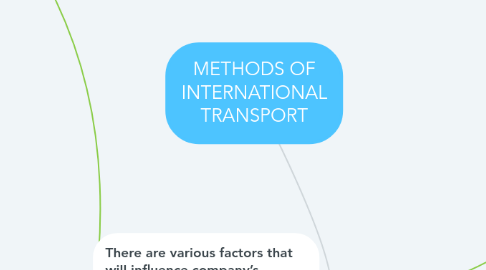METHODS OF INTERNATIONAL TRANSPORT
por alexander Lopez Agudelo

1. There are various factors that will influence company’s decision on which type of transport to use. These factors can be about business’ requirements, destination country, and the type of goods.
2. ROAD
2.1. ADVENTAGES
2.1.1. 1. Low cost
2.1.2. 3. Possibility to schedule transport and tracking the location of goods
2.1.3. 4. Safe and private delivery
2.2. RISKS
2.2.1. 1. long distances overland can take more time
2.2.2. 2. there can be traffic delays and breakdowns
2.2.3. 3. there is the risk of goods being damaged, especially over long distances
2.2.4. 4. toll charges are high in some countries
2.3. 5. different road and traffic regulations on some countries
3. SEA
3.1. ADVENTAGES
3.1.1. 1. possibility to ship large volumes at low costs
3.1.2. 2. shipping containers can also be used for further transportation by road or rail
3.2. RISKS
3.2.1. 1. shipping by sea can be slower than other transport systems and bad weather can add further delays
3.2.2. 2. routes and timetables are usually inflexible
3.2.3. 3. tracking the goods’ progress is difficult
3.2.4. 4. port duties and taxes
3.2.5. 5. further transportation overland might be needed to reach the final destination
3.2.6. 6. basic freight rates are subject to fuel and currency surcharges
4. AIR
4.1. ADVENTAGES
4.1.1. 1. deliver items quickly over long distances
4.1.2. 2. give high levels of security for sensitive items
4.2. RISKS
4.2.1. 1. air transport can involve higher costs than other options, and is not suitable for all goods
4.2.2. 2. flights are subject to delay or cancellation
4.2.3. 3. there are taxes to be paid in each airport
4.2.4. 4. fuel and currency surcharges will usually be added to freight costs
4.2.5. 5. further transportation may be needed from the airport to the final destination
5. PROTECTION AND INSURANCE
5.1. Who wants to transport goods by ship have to protect their shipment with an insurance. But under the maritime transport conventions, there are limited insurances, so it’s advisable to get additional insurance, such as general cargo insurance. For the shipping of dangerous goods, it’s necessary to complete a dangerous goods declaration which includes the Dangerous Goods Note.
6. PROTECTION AND INSURANCE
6.1. It’s possible to choose own vehicles, or carriers. Operating with own vehicles, needs to consider licenses, fuel costs, regulations, driver training and taxes. The international transport of dangerous goods by road is subject to international legislation, in particular the European Agreement on the International Carriage of Dangerous Goods by Road (ADR). Drivers of vehicles carrying dangerous goods must hold an ADR training certificate in handling dangerous goods. All commercial vehicles that carry dangerous goods must pass the ADR test, and some of them need to be built with special standards. These classes of goods are defined as dangerous: corrosive substances, explosive substances and articles, flammable liquids and solids, gases, oxidizing substances, radioactive substances and toxic substances.
7. PROTECTION AND INSURANCE
7.1. General cargo insurance is available in three levels A, B or C. Air transport can also use the Institute Cargo Clauses (Air). The level of insurance is reflected in the premiums that must be paid. So it’s necessary to match the level of insurance to the potential risk of the shipment.
8. PROTECTION AND INSURANCE
8.1. The Convention Concerning International Carriage by Rail (COTIF) is the system of law which applies in the 45 states in Europe, North Africa and the Middle East that are members of OTIF, the International Organization for International Carriage by Rail. CIM (Convention Internationale concernant le transport des Marchandises par chemin de Fer) is a consignment note that sets the conditions for transporting non-dangerous goods by rail. CIM rules mean that ythe carrier only takes responsibility for insuring the shipment against loss or damage from the time they take possession of them until they are delivered. For the transportationof dangerous goods that have a UN dangerous goods code, or that ther carrier considers to be dangerous, it’s necessary to complete a dangerous goods declaration. Part of this declaration is the Dangerous Goods Note


